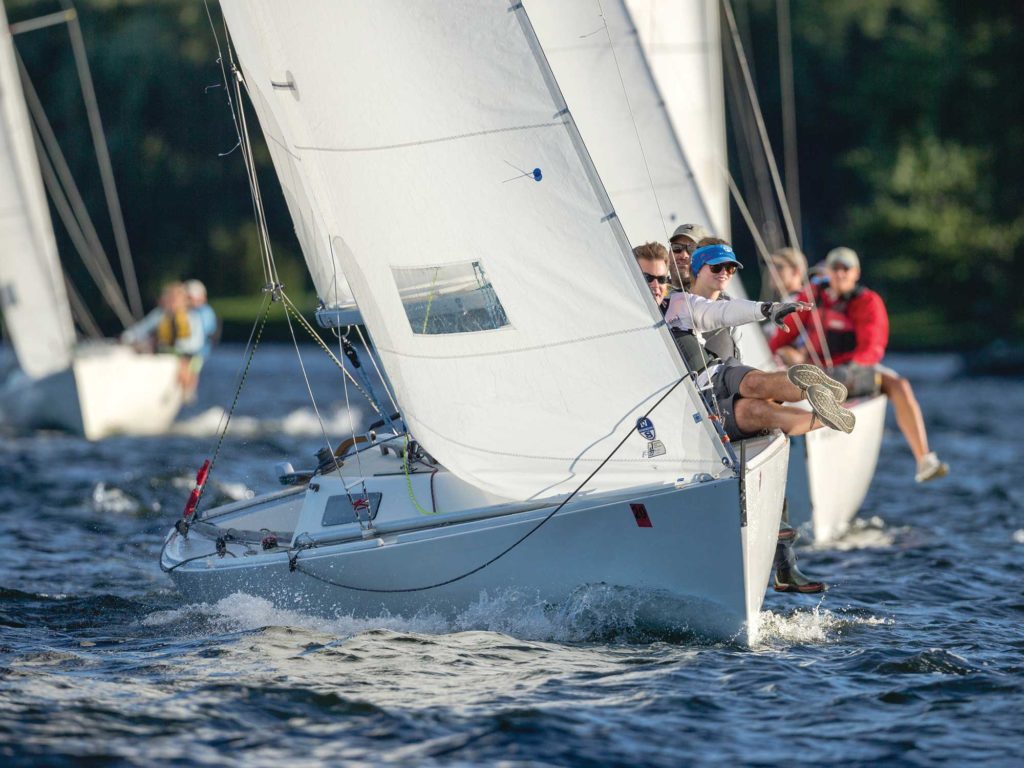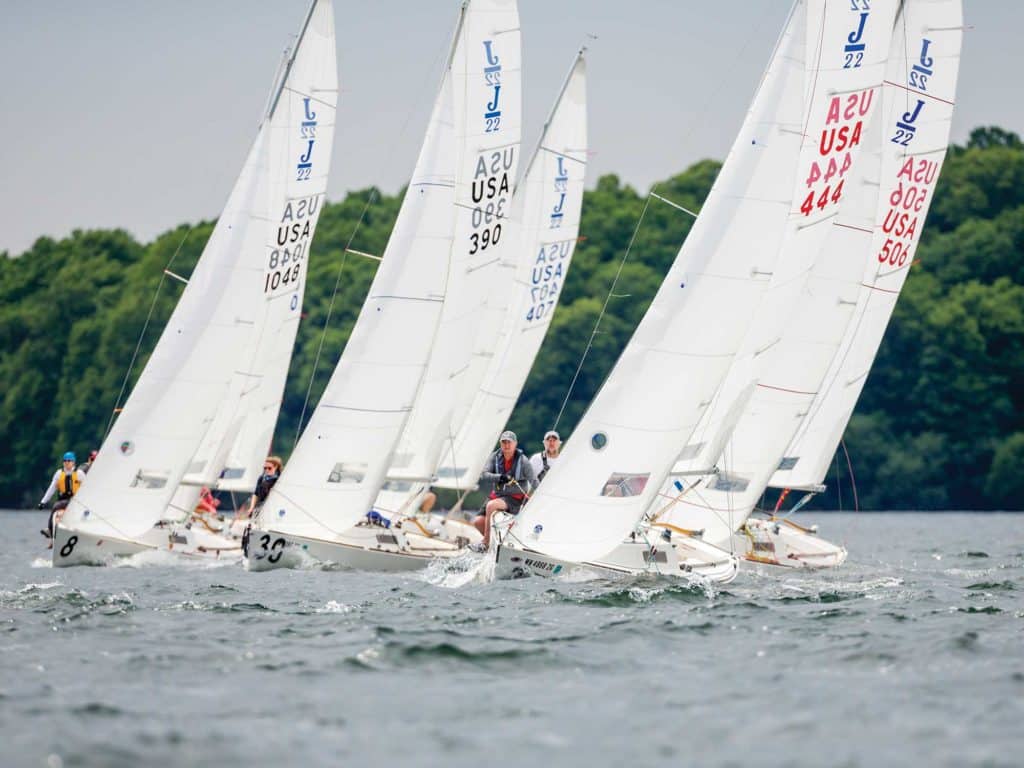
Tactics and boatspeed go hand in hand, and that’s why you look smart when you’re fast. But before we can display our speed and tactical prowess, we have to first develop a big-picture strategy. Weighing all three elements in the heat of a race can be overwhelming, but simplifying the decision-making process helps us focus on what matters most in the moment. The winning formula is to make unemotional, repeatable, high-percentage decisions that, in tandem with solid boatspeed, get us the consistent results we seek.
Let’s start with strategy. This is your big-picture game plan, which you will lay out before the race starts. Once the race is underway, this strategy is constantly assessed and updated to adjust to conditions and the tactical options available to you.
Here’s a hypothetical to consider: Before the race, you decide the winning strategy is to start at the boat end of the line and tack for the right side immediately. But you get fouled at 20 seconds and start in the third row. You now have new information: There are a lot of boats between you and the right side. Your strategy changes. Now your goal is to get to the right side of the course in the cleanest air possible. It’s time for tactics.
Tactics are the decisions we make to execute our strategy in the moment. Sticking with our example: You’re sailing off the line on starboard tack, suffering in bad air. You see a port-tack boat, which also had a bad start, and they’re looking as if they’re going to duck you. You want to get to the right, and if this boat ducks you, they’ll be on your lee bow if you tack, making it hard to control your mode and get to the right with speed. The alternative is to continue for a few more lengths to open up a lane, but that’s not your strategy, right?
Right. So, you make a quick tactical decision and tack to port before the port-tack boat is able to duck. Now you are on its lee bow, and you’re sticking to your strategy. You still might be in the bad air of other boats going right, but you were already in bad air on starboard tack. One boat ducking you might not seem like a problem, but abandoning your strategy in that moment will most likely come back to haunt you later. You can now adjust your strategy as the race progresses, but make sure your tactical decisions set you up to execute your initial game plan.
When establishing your pre-race strategy, focus on four basic considerations: the big-picture weather forecast, current, geographic effects and the wind in which you’re currently sailing. This requires tracking the wind patterns before the start—how big the shifts are, how long they last and what happens when there are changes in strength. Take your best educated guess at the type of racetrack you’ll have, and then do your starting line and racecourse homework: Is the line square to wind direction? Is the weather mark square to the middle of the line? Is the signal boat lying in a direction that indicates current? And if so, how will you approach the line? If you’re confident the right side of the course is favored, then you don’t care as much about which end is favored; your strategy is to start where you can tack to port, with a clear lane immediately. Let everyone else fight for the ends and claim the middle so you can be one of the first boats onto port with a clear lane, sailing fast toward the favored side.
If the wind is oscillating, however, the favored end of the starting line becomes more important. Go ahead and start near the favored end, but the priority is to set yourself up for a quick exit to the right. If there is a major line favor (10 degrees or more), then fight harder to be near that end; if the favor is closer to 5 degrees, you can be more comfortable moving away from there.
Keep tabs on what the wind is doing throughout the pre-start. You can assess this by noting what your angle is to the line on either tack. Maybe you’ve observed that the major wind oscillations come about every three minutes. At 3:15 before the start, you are on starboard tack below the line and notice that you have to sail nearly closehauled to lay the pin. That’s a red flag: The wind is in a left phase, which favors the pin end, and there’s more traffic there as a result. Based on your pre-start observations, you expect the wind will oscillate back to the right between now and the start. If that’s the case, set up closer to the boat end of the line to take advantage of the next shift. Maybe some boats at the pin end have a great start, but as that righty comes in, you will be in a better position.

If the wind is steady and there’s no reason to sprint to one side of the course, then line bias becomes the most important factor. If you don’t anticipate any major shifts, think of the favored end as a head start. You’re simply closer to the weather mark at the beginning of the race. But keep in mind that if there aren’t likely to be major wind changes, limiting your tacks and sailing in clear lanes becomes an exponentially more important strategy. Consider avoiding the favored end by setting up just below or above the pack, in a place where you can be fast and going straight right away.
In addition to being the fastest boat on the racecourse, the best at starting, the best at seeing the future and now the best strategist, every race will be easy, right? Not so fast. In sailboat racing, we deal with myriad variables that are beyond our control. When one of them goes against you, don’t panic. Just weigh your options.
If you know there is a favored side to get to, do it. Sacrifice the perfect lane to go the right way. If your lane is compromised but you are going the right way, look for small opportunities to clear your lane with two quick tacks. Duck a big pack coming across your bow, and let that pack clear out other boats that have been affecting your lane. Here a high duck (slow down by pinching high before a duck) is better than a conventional speed duck.
If the wind is oscillating, always be lifted, on the tack that points your bow closer toward the mark. It’s OK to sacrifice the perfect lane to stay on the lift, because sailing in bad air toward the mark is better than sailing in a clear lane in the wrong direction. If you are sailing in steady breeze, think two steps ahead to manage your lanes so you can sail in clear air for as much of the beat as possible.
Suppose your strategy is wrong—yes, it happens all the time to even the best strategists. Don’t get emotional. Quickly assess why it was wrong and update your strategy. Rinse and repeat all the steps above to adopt this new strategy. Don’t be afraid to look around and check out where the top boats are going. We all do it. If your strategy isn’t panning out, there’s nothing wrong with observing what the hotshots in your fleet are doing and letting them help you figure it out. Connect with their pack and look for trends in their decision-making. Watch and learn from those who have consistent success—that’s always a sound strategy.









